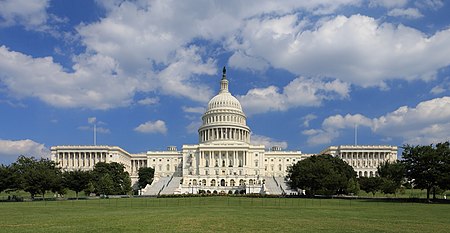United States Capitol

The United States Capitol, often called The Capitol or the Capitol Building, is the seat of the United States Congress, the legislative branch of the federal government. It is located on Capitol Hill at the eastern end of the National Mall in Washington, D.C. Though no longer at the geographic center of the federal district, the Capitol forms the origin point for the street-numbering system of the district as well as its four quadrants. Central sections of the present building were completed in 1800. These were partly destroyed in the 1814 Burning of Washington, then were fully restored within five years. The building was enlarged in the 1850s by extending the wings for the chambers for the bicameral legislature, the House of Representatives in the south wing and the Senate in the north wing. The massive dome was completed around 1866 just after the American Civil War. Like the principal buildings of the executive and judicial branches, the Capitol is built in a neoclassical style and has a white exterior. Both its east and west elevations are formally referred to as fronts, though only the east front was intended for the reception of visitors and dignitaries.
Excerpt from the Wikipedia article United States Capitol (License: CC BY-SA 3.0, Authors, Images).United States Capitol
East Front Plaza, Washington
Geographical coordinates (GPS) Address Phone number Website External links Nearby Places Show on map
Geographical coordinates (GPS)
| Latitude | Longitude |
|---|---|
| N 38.889722222222 ° | E -77.008888888889 ° |
Address
United States Capitol
East Front Plaza
20534 Washington
District of Columbia, United States
Open on Google Maps



